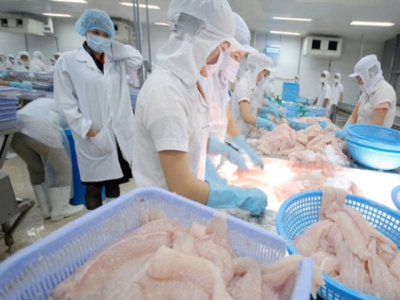Seafood exports to all core markets saw a decrease in January 2020

According to the General Department of Vietnam Customs, in the very first month of new year, the whole country took in more than USD 491.64 million worth of seafood exports, seeing a 32.2% drop compared to December 2019 and 33.7% decrease compared to January 2019.
The country exported a total of 379,000 tons of fish, up 1.3%; 47,200 tons of shrimp, up 6.1% and 75,200 tons of other kinds of seafood, up 1.2%.
FDI companies (those with foreign direct investment) took in USD 41.36 million from exports of seafood, accounting for 8.4% of the total of the country’s export volume.
Japan was the top buyer of Vietnamese seafood, reaching USD 88.72 million, accounting for 18.1% of the total of the country’s export volume and seeing a 18.9% drop compared to December 2019 and 28.2% decline compared to January 2019.
The second was the US with USD 86.68 million worth of seafood import volume, accounting for 17.6% and seeing a 27.5% drop compared to December 2019 and 26.3% decline compared to January 2019.
Seafood exports to the EU market reached USD 69.46 million, accounting for 14.1% of the total of the country’s export volume and seeing 28.9% and 35.7% drop compared to December and January 2019, respectively.
Korea spent USD 69.46 million on buying Vietnamese seafood, accounting for 10.5% and seeing 27.2% and 31.5% drop compared to December and January 2019, respectively.
Vietnam took in USD 45.03 million from seafood exports to Southeast Asia, accounting for 9.2% and decreasing 22% and 32% compared to December and January 2019, respectively.
In January 2020, seafood exports to most markets experienced a fall compared to the same period last year with sharp drop being recorded in Iraq (reached USD 0.15 million, decreased 85%), Switzerland (USD 0.43 million, down 79.8%), Mexico (USD 69.8 million, down 64.8%) and New Zealand (USD 0.84 million, down 62.5%)
On the other hand, noticeable sales were recorded in some countries with considerable increases as compared to January 2019 such as Cambodia (reached USD 4.77 million, up 173.4%), Pakistan (USD 1.65 million, up 103%), Czech Republic (USD 0.43 million, up 42.3%) and Romania (USD 0.94 million, up 54.4%).
According to VASEP, even though Covid-19 has not had a bad impact on Vietnam’s seafood exports in January 2020. However, the local fisheries business may be harmful influenced by the epidemic, at least till the end of first six months of 2020 when exporting to not only China but also other markets.
VASEP’s representative said that seafood exports to border gates account for 20% of total of the country’s export volume to the Chinese market, thus, border gate closure following Covid-19 epidemic spread may result in at least 20% drop of Vietnam’s seafood going to China in the first three months.
The association forecasted that with an optimistic scenario with Covid-9 being wiped out in the quarter I this year, seafood exports to China in the first quarter may reach USD 265 million, down at least 40% compared to the previous quarter but up 10% compared to the same period last year. Recovery will occur in the next quarters and seafood business will come back to normal in the second half of the year and forecast can be made with total USD 1.5 billion from seafood exports and a 5% increase compared to 2019. This can bring in USD 9.25 billion in 2020, up 8% from last year.
In a worse scenario, prolonged Covid-9 epidemic (maybe till August) will seriously affect Vietnam’s seafood exports, resulting in a 30% drop in the first half of the year with USD 400 million and as little as 10% increase in the second half of the year with USD 930 million. The country will take in a total of USD 1.33 billion from seafood exports to China, down 6%. Not only will the worse scenario affect seafood exports to China but also it will slow down the country’s seafood going to other countries. Thus, Vietnam’s seafood exports are forecasted to reach USD 8.9 million in 2020, up only 3-4% from last year.
Có thể bạn quan tâm
 Pangasius industry sees gloomy
Pangasius industry sees gloomy The Mekong Delta farmers of commercial pangasius and baby fish have been experiencing a dramatic drop in selling price for the very first time
 Resolve difficulties in exporting agricultural and seafood products to India
Resolve difficulties in exporting agricultural and seafood products to India These products are produced following standards, quality and safety requirements; however the Covid-19 outbreak has been posing challenges on Vietnam exporting
 Vietnam tightens quality control of shrimp broodstock
Vietnam tightens quality control of shrimp broodstock Shrimp broodstock in the intelligent management system in Vietnam can be imported or caught from the ocean.